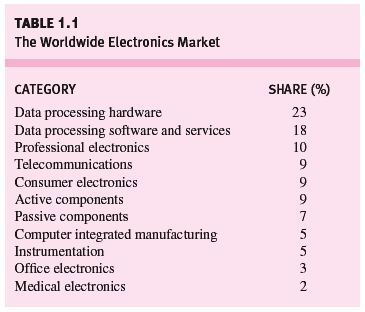
(See related pages)
Activity in electronics began more than a century ago with the first radio transmissions in 1895 by Marconi, and these experiments were followed after only a few years by the invention of the first electronic amplifying device, the triode vacuum tube. In this period, electronics—loosely defined as the design and application of electron devices—has had such a significant impact on our lives that we often overlook just how pervasive electronics has really become. One measure of the degree of this impact can be found in the gross domestic product (GDP) of the world. In 2000 the world GDP was approximately U.S. $40 trillion, and of this total, fully 10 percent, or $1 trillion, was directly traceable to electronics. See Table 1.1 [3–5].  We commonly encounter electronics in the form of telephones, radios, televisions, and audio equipment, but electronics can be found even in seemingly mundane appliances such as vacuum cleaners, washing machines, and refrigerators. Wherever one looks in industry, electronics will be found. The corporate world obviously depends heavily on data processing systems to manage its operations. In fact, it is hard to see how the computer industry could have evolved without the use of its own products. In addition, the design process depends ever more heavily on computer-aided design (CAD) systems, and manufacturing relies on electronic systems for process control—in petroleum refining, automobile tire production, food processing, power generation, and so on. |